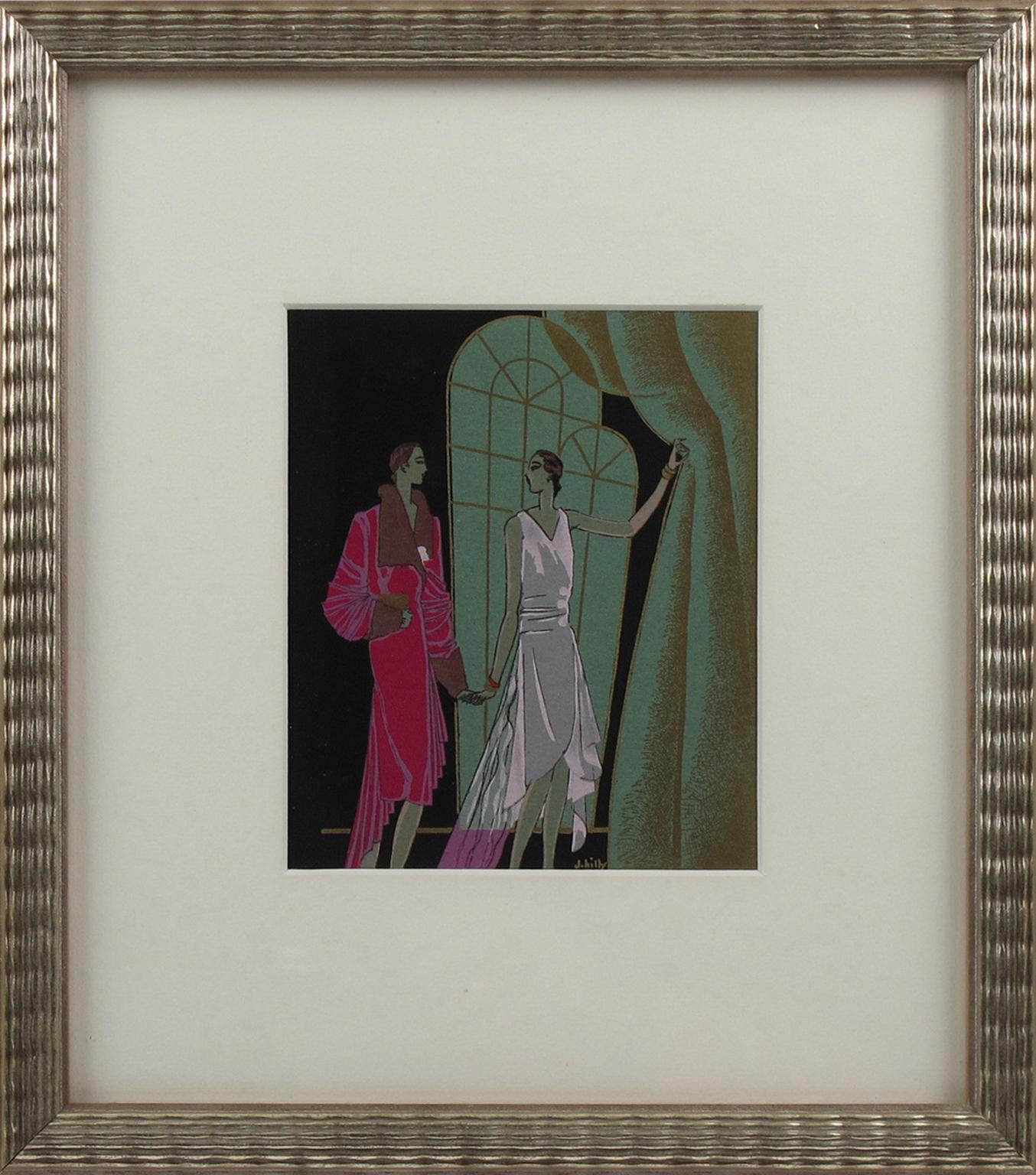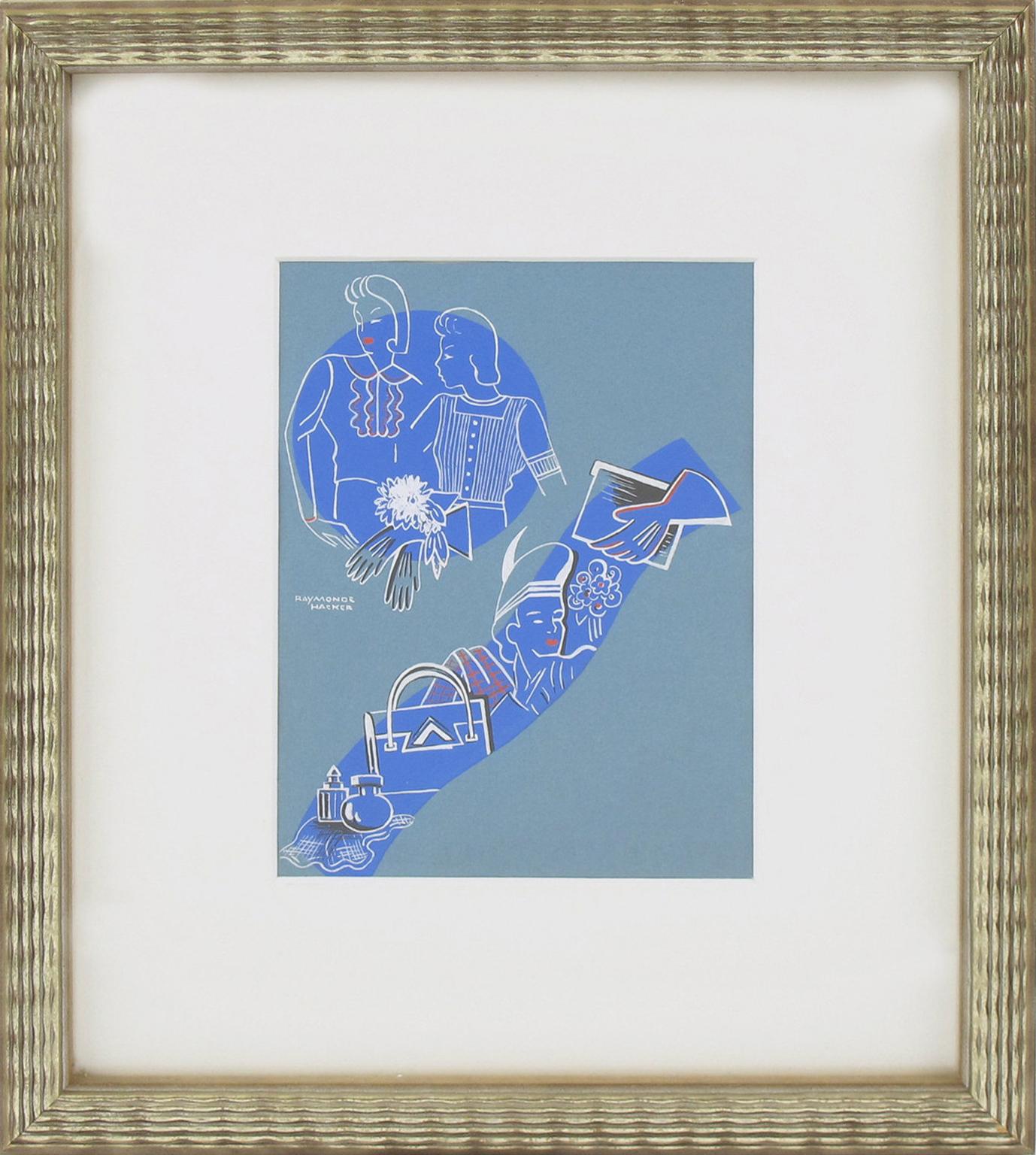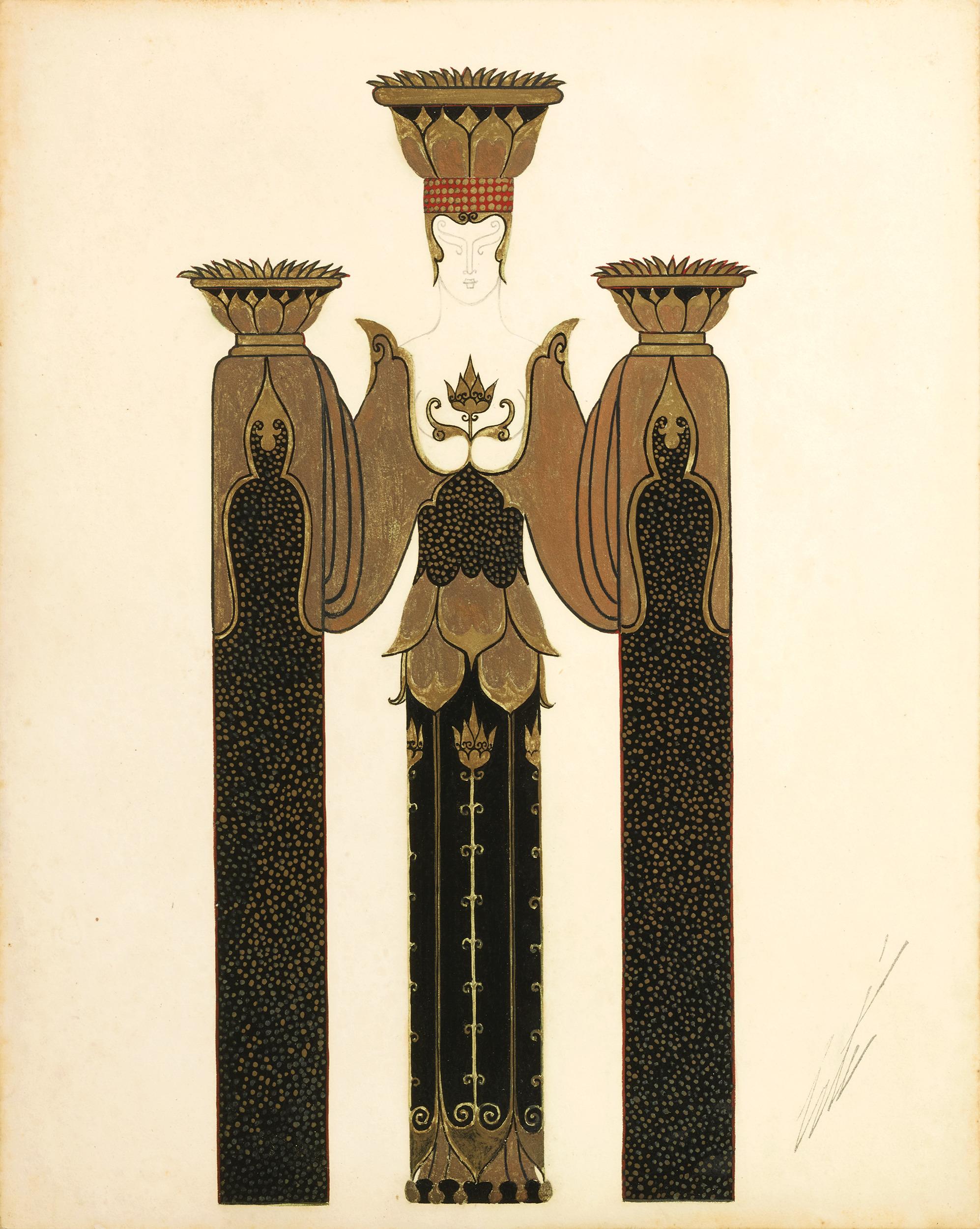Items Similar to Henri Rapin, Gouache on Paper "Fructidor", 1924-1928
Want more images or videos?
Request additional images or videos from the seller
1 of 13
Henri RapinHenri Rapin, Gouache on Paper "Fructidor", 1924-19281924-1928
1924-1928
About the Item
This gouache is a museal and historical piece. Gouache and charcoal on paper stuck on panel by Henri Rapin, France, 1924-1928. "Fructidor". With frame: 80x114x3 cm - 31.5x44.9x1.2, without frame: 66x100 cm - 26x39.4 inches. Henri Rapin made a gift of this project of the great mural realized in the Town Hall of the 15th district of Paris to Robert-Paul Martzloff then Director of the Services of Architecture and Promenades at the prefecture of the Seine, who participated in the choice of the project of Rapin. Dedicated and signed lower right "To Mr. Martzloff in excellent memory HRapin". The frame marked the sheet of paper, it is why we rate this work as fair (see photos).
Decoration project of the vault of the community hall of the 15th arrondissement of Paris. Henri Rapin is the architect of the decoration of the hall of the 15th arrondissement of Paris, which includes stuccos, sculptures, woodwork, low paneling, furniture but also decorative decorative painting. the vault representing in particular the four seasons. The central part of the vault, more flat, is decorated by the painter Octave Denis Victor Guillonnet.
It is interesting to note here that the original project entitled this scene "Fructidor", month of the revolutionary calendar including the days from mid-August to mid-September, and not "Autumn" as it appears on the realization visible at the Town Hall of 15th (see last photos).
- Creator:Henri Rapin (1873 - 1939)
- Creation Year:1924-1928
- Dimensions:Height: 31.5 in (80 cm)Width: 44.89 in (114 cm)Depth: 1.19 in (3 cm)
- Medium:
- Movement & Style:
- Period:
- Condition:
- Gallery Location:Saint Amans des cots, FR
- Reference Number:1stDibs: LU1088213929342
About the Seller
5.0
Vetted Seller
These experienced sellers undergo a comprehensive evaluation by our team of in-house experts.
1stDibs seller since 2018
34 sales on 1stDibs
- ShippingRetrieving quote...Ships From: Saint Amans des cots, France
- Return PolicyA return for this item may be initiated within 2 days of delivery.
More From This SellerView All
- Deschmacker, Young Woman Lying By The Sea, WatercolorBy Paul Alex DeschmackerLocated in Saint Amans des cots, FRWatercolor by Paul-Alex Deschmacker, France, 1920s. This watercolor is in the classical period populated by mythological characters of Paul-Alex Deschmacker, itself becoming part of ...Category
1920s Art Deco Figurative Drawings and Watercolors
MaterialsWatercolor
- Berthomme Saint-André, Before Bathing, 1926By Louis Berthomme Saint-AndreLocated in Saint Amans des cots, FRWatercolor by Louis BERTHOMME SAINT-ANDRE, France, 1926. Befor bathing. With frame: 74x63.5 cm - 29.1x25 inches ; without frame, just the watercolor: 50x36 cm - 19.7x14.2 inches. Si...Category
1920s Art Deco Nude Drawings and Watercolors
MaterialsWatercolor
- James Ward The Fisherman's FamilyBy James WardLocated in Saint Amans des cots, FRPrecious Watercolor attributed to James WARD (1769-1859) - England, 1830-1840. The Fisherman' S Family. Measurements : View : 20"x14.6" (51x37 cm), With frame : 26.6"x21.5" (67.5x54....Category
1830s Romantic Figurative Drawings and Watercolors
MaterialsPaper, Watercolor
- "Boating on the Morin River"By André Dunoyer de SegonzacLocated in Saint Amans des cots, FRPen, ink, watercolor and wash on paper by André Dunoyer de Segonzac, France, 1922-1924. Boating on the Morin River. Measurements : with frame: 52.5x65x2 cm - 20.7x25.6x0.8 inches / without frame: 36.5x45 cm - 14.4x17.7 inches. Signed lower left "A. Dunoyer de Segonzac". Colors may vary slightly depending on your screen. The lighter band at the top and the bottom of the piece, visible in the first picture, is only due to the reflection in the protective glass. It does not exist. In its frame gilt with gold leaf and its protective glass. André Dunoyer de Segonzac was born in Boussy-Saint-Antoine (Essonne) July 7, 1884. After his schooling at high school Henri IV, as early as 1900, he attends classes at the National School of Fine Arts in Paris in free listener where he will befriend Charles Dufresne. In 1903, he enters the private studio of Luc-Olivier Merson. In 1907, he studies with Jean-Paul Laurens and attends the La Palette and Colarossi academies in Montparnasse. He meets Luc-Albert Moreau and Jean-Louis Boussingault with whom he shares a studio. His first drawings are published in 1908 in The Great Review and The Witness. Nearly indifferent to contemporary aesthetic revolutions, Dunoyer de Segonzac undertakes, with Jean-Louis Boussingault and Luc-Albert Moreau, to revive Gustave Courbet's realism by performing still lifes, nudes, landscapes, in a thick paste and masonry . In one of his letters to the painter Maurice Boitel, he wrote in the 1950s: "I have not forgotten the heroic period of the independents - when we were grouped around Paul Signac, the charming and valiant Maximilien Luce - in these barracks where the living and authentic Art was grouped outside the academic formulas - or literary and systematic tendencies - which were to lead to this abstract aesthetic of which the painting dies. " In 1908, he begins exhibiting at the Salon d'Automne and the Salon des Indépendants, with Paul Signac and Maximilien Luce. He befriends Apollinaire, Max Jacob, Raoul Dufy and Vlaminck. From this period, renting a house belonging to Signac, Dunoyer discovers the landscapes of Saint-Tropez, to which he will remain faithful and where he lived until the end of his life. He stays in Saint-Tropez only in the summer season. For the rest, he leads a real nomadic life, in search of the motive especially through the Île-de-France, the Grand Morin valley, Feucherolles, Chennevières-sur-Marne, Guyancourt, etc. "I also worked a lot on the banks of the Seine in Chatou, Bougival, Andrésy, Poissy and Triel that I particularly like, with its beautiful Gothic church that is reflected in the Seine and the high wooded hills that surround him", he will say. In 1910, he knows fashion designer Paul Poiret and meets Max Jacob, Raoul Dufy and Vlaminck. From 1910 to 1914, he travels to Italy, Spain, North Africa, and is interested in sport and dance (drawings of Isadora Duncan's Russian Ballets, 1911, The Boxers1910). From 1914 to 1918, mobilized in the infantry, he makes the war hardly, before being assigned to camouflage. He performs many war drawings, valuable for their artistic and documentary value. From 1919, he appears again in many exhibitions, including major Parisian salons. Nearly indifferent to contemporary aesthetic revolutions, Dunoyer de Segonzac undertakes, with Boussingault and Moreau, to revive Courbet's realism by performing still lifes, nudes, landscapes, in a thick and masonry paste. Enlisted in engraving by Jean Émile Laboureur, he makes nearly 1,600 brass plaques from 1919 to 1970. He was president of the Society of French painters-engravers. In 1921, he meets Paul Valéry, Léon-Paul Fargue and Jean Cocteau. In 1928, he makes a trip to America where he met with great success. In 1930, he becomes friend with Derain. In 1933 he receiveds the Carnegie Foundation of Pittsburgh Award and in 1934 the Venice Biennale. During the Occupation, in November 1941, he takes part in a "study trip" to Germany, organized by Arno Breker, accepting, like other artists of the most renowned, to visit the hotspots of German culture as well as artist workshops. After the war, he is exhibited in the best galleries...Category
1920s Realist Figurative Drawings and Watercolors
MaterialsPaper, Ink, Watercolor, Pen
- Berthomme Saint-André, The Nap, Watercolor, 1925By Louis Berthomme Saint-AndreLocated in Saint Amans des cots, FRWatercolor by Louis BERTHOMME SAINT-ANDRE, France, ca.1925. The nap. With frame: 75x60.5 cm - 29.5x23.8 inches, without frame, just the watercolor: 53x39 cm - 20.9x15.35 inches. Signed lower left "Berthomme St André" (see photo). Louis Berthommé Saint-André is a figurative painter, fresco painter, decorator, illustrator, engraver, ceramist and French lithographer born in 1905. He comes from rural and commercial France: his father ran a wine and grocery business. In his youth, Louis Berthommé Saint-André was injured by a kick, which left him with a stiff leg, preventing him from driving, among other things. The family left Oise to settle in Saintes, where the artist studied at La Recouvrance. He entered as a student architect with Georges Naud, responsible for the historical monuments of Charente then, in 1921, he entered the School of Fine Arts in Paris. Louis Berthommé Saint-André is one of the great representatives of French figurative painting in the 20th century. He was trained at the School of Fine Arts by two very old masters who died during his training: Fernand Cormon (1845-1924) and Jean-Paul Laurens (1838-1921). He retains from their training the taste for well-learnt techniques, but from his first works, he is part of modernity. His constructions show decomposed forms inspired by Cézanne, while maintaining a keen sense of rigour. He never strayed from realism, but his very colourful, sometimes incisive palette and his freedom in representation gave his painting a bite and an acidity that placed Louis Berthommé Saint-André among the great talents of his time. Silver medal at the Salon of French Artists where he exhibited from 1924 to 1929, he won the Abd-el-Tif Prise in 1925 and was then the youngest resident of the villa in Algiers. Friend of Jean Launois, in addition to his recognised portraits, he painted Algiers and the Kasbah. His studies of women recall those of Eugène Delacroix, but if his luminous inspiration is due to the Algerian sun, his touch is more Cézanne than purely orientalist. He left Algeria in 1928, to return there in 1931. Before the war, Berthommé Saint-André exhibited regularly in all the major Salons: from 1928 at the Salon d'Automne, at the Salon des Beaux-Arts (1934 to 1936) at the Salon des Tuileries since 1935. His inspiration is close to surrealism . During the Occupation, he became very "fauve", in reaction to the darkness of the war. He joined the Resistance, and collaborated with Vaincre (Resistance newspaper). After the war, he developed a style close to poetic reality (Brianchon, Legueult, Oudot, Terechkovitch, Cavaillès. Caillard, Limouse, and Planson), without however ever being part of the group so called. He is present at the Salon Comparaison, at the Salon of painters Witnesses of our time, is president of the Salon of drawing and water-based painting. He has exhibited solo internationally, in Europe, the USA and Japan in particular. In 1977, he received just before his death, the grand prise of Painters Witnesses of their Time. He died on October 1, 1977 in Paris. Bibliography - Michel Droit. Berthommé Saint-André. Éditions de la revue moderne, 1981 Wall frescoes Entrance to the Direction, National School of Fine Arts, Paris Lycée Charlemagne, Paris, Notre-Dame and the banks of the Seine, 1952 Staircase of the Staff of Poitiers Personal exhibitions Villa Abd-el-Tif, Alger, 1922 Galerie Armand Drouant, Paris, 1928 Galerie Marcel Bernheim...Category
1920s Post-Impressionist Nude Drawings and Watercolors
MaterialsPaper, Watercolor
- Madeleine RENAUD, Watercolor, The Wreath Of CarnationsLocated in Saint Amans des cots, FRWatercolor by Madeleine RENAUD (1900-1994), France. Wreath of Carnations. With frame: 60.2x89 cm - 23.7x35 inches without frame: 73x43 cm - 28.7x16.9 inches. Signed "Madeleine Renaud...Category
20th Century Impressionist Figurative Drawings and Watercolors
MaterialsWatercolor
You May Also Like
- Original French Art Deco Gouache Illustration Drawing by J. HillyLocated in Atlanta, GAAn original Art Deco illustration hand-painted with ink and gouache on paper. The drawing features two elegant women with large windows and drapery in the background. This illustrati...Category
1930s Art Deco Figurative Drawings and Watercolors
MaterialsPaper, Ink, Gouache
- French Art Deco Original Gouache Illustration Drawing by Raymonde HackerLocated in Atlanta, GAA French Art Deco illustrative drawing, hand painted in ink and gouache on blue laid paper. The design includes a collection of fashion accessories, handbags, gloves, hats, and perfu...Category
1930s Art Deco Figurative Drawings and Watercolors
MaterialsPaper, Ink, Gouache
- Costume Oriental by ErtéBy Erte - Romain de TirtoffLocated in New Orleans, LAErté (Romain de Tirtoff) 1892-1990 | Russian-French Costume Oriental Signed “Erté”(lower right) Inscribed "No. 19" (en verso) Gouache on paper Titled Costume Oriental, this ensemble epitomizes Erté's signature fusion of Eastern and Western aesthetic elements. The attire features grey pantaloons enveloped by a vivid red skirt adorned with intricate white Orientalist motifs. The bodice, a geometric tapestry of black and white stripes, is composed of narrow horizontal black bands juxtaposed with glittering gemstones. This visual harmony is accentuated by a trio of diamond shapes vertically aligned on the chest. The crowning element is a gem-encrusted turban, surmounted by three red fan shapes, lending the headpiece the appearance of a striking medallion. This sartorial masterpiece is an authentic Erté creation for the 1926 rendition of George White's Scandals, staged at the Heilig Theatre in Portland, Oregon. The revue initially debuted at the Apollo Theatre in New York City on June 30, 1924, enjoying a run of 196 performances before embarking on a tour. Orchestrated by George White from 1919 to 1939, the Scandals series distinguished itself through its timely comedy and exceptional choreography, a testament to White's expertise as a dancer. In contrast to the more lavish Ziegfeld Follies,Scandals offered a streamlined yet sophisticated experience. The Sixth Edition was particularly remarkable for its artistic collaborations: Erté designed the scenery and curtains, while George Gershwin composed the musical score, which included the classic "Somebody Loves Me." The production featured an ensemble of notable performers, including Nyra Brown and the Leeland Sisters. The artist, Russian-French visionary Romain de Tirtoff (1892-1990), popularly known as Erté, began his artistic journey in the culturally rich city of St. Petersburg, where he developed an early fondness for ballet and theatrical performances. He moved to Paris in 1912 to study architecture, and quickly found his creative niche in crafting fantastical costumes for the city’s bustling nightlife. Erté‘s expertise, refined under the guidance of the famed Paul Poiret, captured the attention of Harper’s Bazaar, marking the beginning of a significant partnership that spanned from 1915 to 1936. The artist also designed sets for notable cinematic masterpieces including Ben Hur and La Bohème, and created sets and costumes for cabarets, operas and other performances at the Folies-Bergères, Bal Tabarin, the Théâtre du Bataclan and Le Casino de Paris. Often remembered as the “Father of Art Deco,” Erté was a trailblazer whose colorful creations shaped the groundbreaking Art Deco era more than any other, leaving an indelible mark on the history of art and design. His artworks reside in prestigious museum collections worldwide, including the Metropolitan Museum of Art in New York, the Victoria & Albert Museum in London and the Los Angeles County Museum of Art. Painted 1926 Paper: 12“ high x 9 wide Frame: 19 1/4“ high x 16 1/8” wide x 5/8" deep Exhibitions: M.S. Rau, New Orleans, Erté and the Era of Art Deco, October 14, 2023 - January 3, 2024 Provenance: Private collection, Paris Christie's South Kensington: Sale, 2014 Bouret Gonzalez Collection Sydney and Sibyl Colefax...Category
20th Century Art Deco Figurative Drawings and Watercolors
MaterialsPaper, Gouache
- Betty by ErtéBy Erte - Romain de TirtoffLocated in New Orleans, LAErté (Romain de Tirtoff) 1892-1990 Russian-French Betty Signed "Erté" (lower right) Stamped "Erté, Romain de Tirtoff" (en verso) Inscribed N°114.4 (en verso) Gouache on paper This...Category
20th Century Art Deco Figurative Drawings and Watercolors
MaterialsPaper, Gouache
- Salade de Fleurs de Lotus by ErtéBy Erte - Romain de TirtoffLocated in New Orleans, LAErté (Romain de Tirtoff) 1892-1990 | Russian-French Salade de fleurs de lotus (Lotus Flower Salad) Inscribed “n°1.497” (en verso) Gouache on paper In 1929, Erté embarked on the cr...Category
20th Century Art Deco Figurative Drawings and Watercolors
MaterialsPaper, Gouache
- Mistinguett by ErtéBy Erte - Romain de TirtoffLocated in New Orleans, LAErté (Romain de Tirtoff) 1892-1990 Russian-French Mistinguett Signed "Erté" (lower right) Stamped "Composition originale" (en verso) Gouache on paper Erté designed this costume fo...Category
20th Century Art Deco Figurative Drawings and Watercolors
MaterialsPaper, Gouache
Recently Viewed
View AllMore Ways To Browse
Art Deco Henri Rapin
Pen Artwork
Joseph Kudelka
Old World Baby Cradle
Olivia Kemp
Pastel And Watercolour Unknown
L7 Maine
Craig Alan Colour
Madras Sofa
George Hess
Angel Ricardo Ricardo Rios
Ram Oil Painting
Steven Grossman Fashion And Art
Egg Cup Stand
Miroir 17
Russian Stomacher
Miniature Stone Birds
Plastic Surgery





